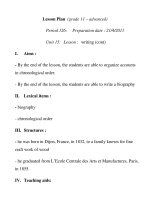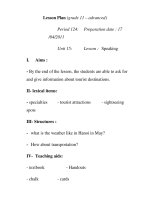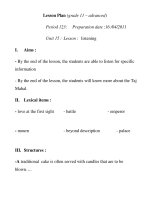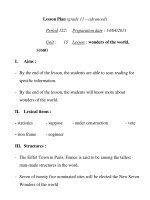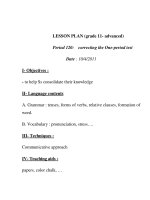Lesson Plan (grade 11 – advanced) Period : 24 pot
Bạn đang xem bản rút gọn của tài liệu. Xem và tải ngay bản đầy đủ của tài liệu tại đây (21.96 KB, 11 trang )
Lesson Plan (grade 11 – advanced)
Period : 24 Preparation date :
16/10/2011
Unit :3 Lesson : Language
Focus- grammar
I. Aims :
- By the end of the lesson, the students are able to from
and use compound nouns.
- By the end of the lesson, the students are able to use
correct verb forms: base form, to + bare form and V-
ing form
II. Lexical items :
- compound nouns - justify
-resist - rehearse
III. Structures :
- A station from which trains leave./A cup for holding
tea.
- Everyone seems to have a good time.
IV. Teaching aids:
- textbook - handouts - pieces of
paper
- chalk and board
V. Techniques :
- writing-based ( communicative approach.)
VI. Procedures :
State/time Teacher’s and
students’
activities
Blackboard
Materials
1. warm-
up
(4’)
Game: Saying “
what it means”
- arrange the class
into groups of four
students.
- Place a pack of
cards face up in
the middle of each
group.
-In turn each
student in the
group gives the
meaning of the
word on the card
face up on the top
of the pack ,and
the new card is
defined as before
Word cards:
1.shoe shop
2.Milk
chocolate
3.Book case
4.chocolate
milk
5.tennis ball
6.history
book
7.Gues house
8.Milkman
9.Paperbag
10.Street
-Pictures
- chalk
and board
-Monitor the
groups and note
down errors for
correction at the
end
Transition: In
today’s lesson ,
we’ll get to learn
more about
compound nouns
and other
grammar points.
lights
Unit 3:
Language
Focus –
Grammar.
2. Word
study
(8-10’)
compound nouns
- Elicit the form
from SS
FORM
N+N =
A bookshop
is shop
where you
can buy
- textbook
- Chalk
and board
(10’)
(10’)
compound nouns
- Draw SS’
attention to the
following points:
+the first noun is
normally singular
but the meaning is
often plural.
+The tow nouns
are often written
as separate words,
but we sometimes
use a hyphen(-) ,or
we write them as
single word.
+There are no
exact rules about
whether we join
books
An apple a
tree that
has/produces
apple
A tea break
at the tea
table a large
teapot
.
- chalk &
board
-
Textbook
the tow separate
words.
USE: to mean one
thing/ person/idea
+the first noun is
like an adjective-it
tells us what kind
of thing/
person/idea, ete
.For example:
A tennis ball = a
ball used to play
tennis
A taxi driver = a
person who drives
a taxi
+Sometimes the
first noun tells us
-
handouts
- chalk &
board
- textbook
which thing etc. is
meant.
Garage roof = the
temperature of the
sea
- Elicit the tense,
form , use and
time these
sentences indicate.
Activity 1 :
Writing
compound
nouns(taska,p.42)
- Have SS do task
a textbook, p.42
- Call on SS to
speak out the
-
Textbook
3.Verb
forms
answers
-Invite class
opinions and give
feedback.
Activity 2:
Match-up (task
b,p.42)
- Have SS match
up a noun in
column A with
one in column B
to form a
compound noun
- Call on SS to
write answer on
the board
-Go over the
answers with the
hole class.
Activity 1:
Choosing the
correct verb
form(task b ,
p.43)
-Have SS to task
b( textbook , p43)
-Call on SS to
speak out the
answers and then
write them up on
the board.
-Elicit class
opinions and give
feedback
Activity 2:
Choosing the
correct verb
form(task c , p.44)
-Put SS into pairs
and have SS do
task c( textbook,
p.44)
-Call on SS to
speak out the
answers
-Elicit class
opinions and give
feedback
5.
Homework
(1’)
Label collecting
Ask SS to collect
food labels that
contain compound
nouns.
.
-Handout
Examples:
Cornflakes,
chicken soup,
chocolate milk,
juice drink….

